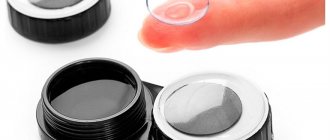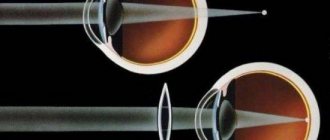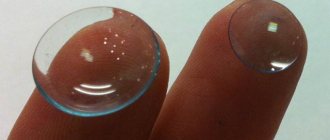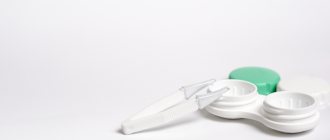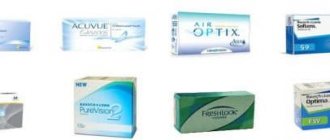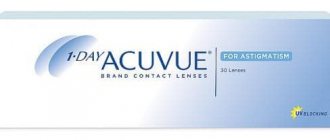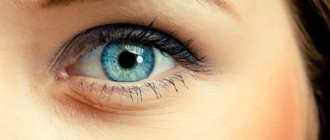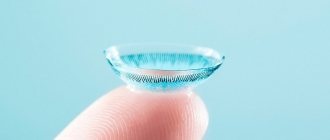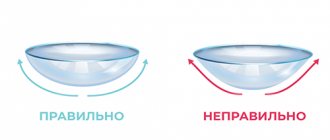Which daily lenses are better - comfortable to wear, easy to care for, easy to clean. Ophthalmologists consider the highest quality optical products to be those that transmit oxygen well and retain moisture. In this case, you don’t have to worry about irritation of the cornea or the feeling of eye fatigue in the evening. Most daily disposable lenses meet these requirements.
Advantages of daily lenses
Buying contact lenses in Moscow is not difficult. One-day optical products top the rating of lenses that ophthalmologists recommend to patients in the first place. Doctors always take care of the safety of the eyes, because the presence of foreign objects in them can worsen the condition of the visual system. During wear, protein and lipid (fat) deposits form on the surface of the lenses. Therefore, after 8-10 hours, the clarity of vision decreases somewhat, and heaviness is felt in the eyes.
To clean contact optics for extended or long-term wear, you have to resort to rinsing and soaking overnight. But no matter how thoroughly a person rinses the lens in the morning, foreign microparticles still remain on it. One-day models are simply thrown away before bed, and a new pair is put on in the morning.
Features of monthly lenses
As you understand, not everyone can afford daily lenses due to their high cost. It is much cheaper to buy durable products. There are two types of monthly lenses:
- daytime;
- extended wear lenses that you can sleep in.
The second type of lenses is usually made of silicone hydrogel material, which has excellent oxygen permeability and does not have a low elasticity coefficient. Long-term wear lenses are comfortable to sleep in. Moreover, with continuous use, the patient forgets that there are foreign objects in the eyes.
Read more about soft lenses here.
Advantages
The advantages of monthly lenses are quite significant:
- Affordable price for most users.
- Excellent image clarity, maintained even in the twilight. This is a huge plus for car drivers.
- Silicone hydrogel extended wear lenses do not need to be cleaned, disinfected or stored in special solutions.
- Such lenses are convenient to wear for those who are engaged in hazardous work, work in air-conditioned rooms, or spend the whole day at the computer.
It is better not to wear these lenses for more than a month, as harmful deposits accumulate on them.
Today you can choose monthly lenses from the world's leading manufacturers. The main thing is to know your diopters, as well as the radius of the base curvature of the cornea. Monthly lenses are made from hydrogel and silicone hydrogel. The second type of lenses allows oxygen to pass through better, but costs 2 times more. Expensive models of silicone hydrogel contact lenses have UV protection. They are not able to completely replace sunglasses, but when paired with them, they perfectly protect the lens from burning rays.
How do lenses fit to the eye?
Monthly lenses are suitable for all types of vision problems: “plus”, “minus” or astigmatism. Like daily lenses, monthly lenses are presented in a wide range: colored, lenses with an ultraviolet filter, as well as with other important functions.
Lenses of this type are highly hygienic. They are specially designed for long-term wear, so they do not tend to accumulate sediments of tear fluid, bacteria, and protein deposits. Another plus is obvious savings compared to daily lenses.
Lens storage container
Read more about extended wear lenses here.
Flaws
The obvious downside to monthly lenses is the need to use containers and solutions. After all, you will have to clean them before putting them on again.
If you wear daily monthly lenses for more than 8 hours a day, use moisturizing drops.
Optimal material
Until 1998, the range of optical stores was represented exclusively by hydrogel daily contact lenses. But due to certain shortcomings of such models, the development of others, made from better materials, did not stop. Silicone hydrogel products soon appeared on sale. Unfortunately, they are also not without their drawbacks.
Hydrogel
The latest generation models have been improved; unlike their predecessors, they allow oxygen to pass through quite well and prevent excess moisture evaporation. The downside is the feeling of heaviness that occurs in the late afternoon. When choosing lenses, you should focus on the hydrophilicity indicator. The closer it is to 78%, the safer the product. 1 dayacuvue moist and dailies aqua comfort plus are especially in demand.
Silicone hydrogel
Unlike hydrogel lenses, such lenses allow oxygen to pass through perfectly. This allows one to avoid compensatory growth of blood vessels into the cornea due to hypoxia. But they also have a drawback - the hydrophobicity of siloxane. It does not retain moisture well, which leads to the lens losing its elasticity after several hours of wear. The outer shell of the eye dries out and becomes irritated due to the excessively tight fit of the thin plate to the cornea. Such disadvantages are uncommon for such models:
- 1-day acuvue try eye;
- dailies total 1;
- myday;
- acuvue oasys hydralux.
While hydrogel models come in different wearing modes, silicone hydrogel models are intended for use only for 24 hours. They should not be cleaned by soaking them in ophthalmic solutions. Contact lenses cheap in our online pharmacy.
What are eye lenses
Many believe that this is an ideal solution for contact correction of vision defects. They are applied directly to the mucous membrane of the eye and completely cover the pupil area. At the same time, the products do not limit, but expand the field of vision and protect the pupil from injury. Anyone can buy contact lenses today, but the choice of such products should always be agreed upon with an ophthalmologist. Depending on the materials used, they are divided into two groups: soft and hard.
Soft
According to consumers, soft contact lenses are the most convenient and comfortable; once you try them, it is difficult to go back to glasses. They are made from a composition that is able to absorb water, becoming flexible and at the same time allowing oxygen to pass through - thanks to this property the eye breathes. According to the method of wearing, soft CLs are also divided into two types:
- Traditional ones are those that do not have a long service life, but require daily replacement.
- Scheduled replacement - do not cause irritation when worn constantly, require replacement 1-2 times a month.
Hard
This type of CL is prescribed by ophthalmologists in cases where the patient has a curvature of the cornea or other severe visual impairments - for example, to correct astigmatism, if refraction is impaired, for people with different diopters or with keratoconus (when the cornea is not spherical, but cone-shaped). The advantage is that they are easier to care for, but wearing contact lenses for the first time may cause discomfort when blinking.
Hard contact lenses are made to order, taking into account the individual parameters of the patient. Thanks to the elastic frame, this type of CL holds its shape well, does not cause allergic reactions, and is more durable. Depending on the characteristics they are divided:
- hard gas-permeable type - allows oxygen to pass through;
- gas-tight - block air access.
Biocompatible
Biocompatibility - the possibility of contact with any foreign object without harm to health. In ophthalmic practice, the term refers to the ability of the material used for production to interact with the eyeball without causing undesirable consequences. For this purpose, special substances are added at certain technological stages. They are physiological, that is, they are constantly found in tears and mucous membranes. In the ranking of biocompatible lenses for daily wear, bio true one day, pro clear 1 day, and adria one day are firmly in the leading positions.
Choosing traditional eye devices
Lenses with a wear life of six months, so-called traditional lenses, are attractive because they are inexpensive and have an increased density. Such lenses are used to correct refractive pathologies such as astigmatism, myopia, and farsightedness. They do not cause image distortion or changes in the field of view.
Traditional lenses, being the most favorable option in terms of price, contain a small amount of moisture, have low oxygen permeability and are thick. They differ from other lenses in that they are produced in special bottle packaging.
These lenses are designed to be worn during the day; they must be removed at night; they can be worn for no more than ten hours a day. This is necessary so that the eyes have time to rest from contact lenses and be enriched with oxygen.
The main disadvantage of traditional lenses is that due to such a long period of use, a large number of bacteria and protein deposits accumulate on their surface, and microcracks and other damage can often form. Therefore, they require even more careful care.
If you still choose such lenses, I can advise you on the manufacturers who make extended-release lenses best:
- Pure Vision;
- ACUVUE;
- Clariti;
Traditional contact lenses are the best option for budget-conscious people. If you take proper care of them, they will not be inferior in comfort to lenses with shorter wearing periods.
Aspherical
The fundamental difference between such contact optics and spherical optics is the design. The front surface of the lens has an ellipsoidal shape, so the diameter of the curvature increases from the center to the edges, which increases contrast sensitivity. When wearing aspherical products, any distortion is excluded. Such an “eye-lens” system is considered the most advanced in ophthalmology. By increasing the contrast of vision, the perception of objects becomes clear and sharp. The most popular in this category are soflens daily disposable, pro clear 1 day, bio true one day.
How to choose the best option
Manufacturers offer a variety of contact correction products – who are they suitable for and which ones? There are several accepted selection criteria:
- lifestyle or specific situation: if a person is constantly involved in sports, extreme hobbies, goes on short trips, one-day lenses are suitable for him, works in an office at a computer - two-week ones;
- properties of vision and the eye - lenses of a certain period from different manufacturers are not always designed for a certain curvature (for example, for 8.8 there are almost no alternatives to two-week ones) or optical power, they may not be suitable for people with astigmatism;
- characteristics of the cornea - sensitivity, dryness, tendency to inflammation, allergic reactions, according to which the parameters of gas permeability, wettability, edge thinness, material and other characteristics are selected;
- personal preferences - some people don’t like to clean their lenses every day, others want to save a little money;
- recommendations from an ophthalmologist - he will determine the condition of the eye and give professional advice.
Key brands and manufacturers of short-wear models are Johnson & Johnson, which produces the popular Acuvue (Trueye and Moist for one day and Oasys for 14 days), the Japanese Menicon. Adria has interesting color models with diopters. Each manufacturer attracts customers with innovative solutions to improve the comfort and safety of lenses, and the choice must be made individually, in consultation with an ophthalmologist and taking into account the budget.
Toric
Such optical products are designed to be worn by patients with astigmatism. This is a congenital or acquired refractive error in which incoming rays are focused not at one, but at several points. The design of the toric lens provides a thickening at the bottom or areas of special stability. Unlike the usual spherical and aspherical models, such a product is not capable of moving. Acuvue moist for astigmatism and daili estoric are often the first choice lenses for patients with astigmatism.
Basic recommendations for buyers
How well your lenses are chosen will depend on how comfortable they will be to wear.
The selection of contact lenses should only be trusted by an ophthalmologist. Selection must be done individually. You should not do this yourself if you do not want to have eye bleeds in the future, such as dry eye syndrome, pathological changes in the cornea due to hypoxia, as well as inflammatory diseases.
The doctor performs an examination, which consists of:
- determination of visual acuity;
- fundus examination;
- keratometry (assessment of the curvature of the anterior surface of the cornea);
- autorefractometry (determination of eye refraction).
After the examination, we proceed directly to the selection of lenses. They are selected according to the following parameters:
- material;
- type of lenses;
- lens cruelty (hard or soft);
- wearing time;
- application (simple, for treatment);
- color (transparent or colored).
If you choose the right contact lenses and follow the rules of wearing and hygiene, the lenses will be comfortable to wear all the time.
Colored
These are optical products for radically changing eye color. They allow a brown-eyed girl to become blue-eyed and vice versa in a few minutes. The harm of such lenses to visual acuity is nothing more than a common misconception. The coloring pigment is located in the area of the iris, which does not have any effect on the perception of objects located near or far. This group can include tint and carnival lenses for daily wear. Fresch look color blens 1 day, beauty lenses 1 day acuvue define radically change your appearance without harm to your health.
Favorable price for lenses - buy optics from an official supplier
High-quality lenses can be purchased at a favorable price if you make a purchase not in retail stores, but through the website of official suppliers. You can save about 20% of money by buying optics not individually, but in large packages for a quarter or a year.
We offer certified products from well-known brands: Acuvue, Purevision, Air Optix, Alcon, Cooper Vision, Proclear, which we order directly from manufacturers. See the current catalog of contact lenses on our website. You can buy the goods presented on the website via the Internet and arrange delivery to your city. Prices are indicated in rubles.
The ordered goods are sent to the regions by mail, courier services and transport companies. Contact store managers for more information about product prices and delivery services.
Advantages and disadvantages of two-week lenses
Two-week lenses have the following advantages over other types:
- high oxygen permeability, due to which the cornea of the eye is not irritated and does not dry out;
- high level of comfort during use;
- protection against infections and exposure to ultraviolet radiation;
- unpretentiousness in maintenance;
- high strength.
Two-week models are good because during their use, harmful microorganisms do not have time to accumulate in the material from which such optics are made.
Important! In this regard, products for monthly use are not so practical: over time, microcracks and scratches form on the products, in which bacteria accumulate.
And no matter how careful the care is, over time, colonies of microorganisms that cannot be completely removed begin to negatively affect the membrane of the eye. If replaced every two weeks, this danger is eliminated.
There are practically no negative aspects to using two-week optical products, except for the need to properly store lenses and monitor their service life.
Towards the end of this period, the lenses lose their properties, and if you use the optics for 24 hours without removing them, this period expires even faster.
How are they different from menstruation and biweekly?
When choosing which type of lenses is best for you, you should rely on the characteristics of your body, working conditions and experience in wearing lenses.
First of all, you should know that one-day ones are much more comfortable due to the fact that they are well moisturized and allow more oxygen to pass through. Therefore, if a person with poor vision wants to wear really comfortable and safe lenses on their eyes, it is better to stick to daily models. But high-quality one-day models will cost more than options for long-term use.
If the patient is faced with a question of choice, but the person is limited in funds, it is better to take a closer look at two-week or monthly. The latter are the most economical, but they are also the most demanding to maintain. Two-week ones are a kind of golden mean of quality and price.
Taking care of your eyes is always challenging, especially for people with poor vision. Choose lenses that are as comfortable as possible for your eyes. Sometimes, to make an informed choice, you have to compare several brands to understand which models wear better and do not cause discomfort.
Also pay attention to the frequency of wear and calculate how much the lenses cost compared to offers for long-term wear, and whether such a purchase is profitable
What are the differences from one-day and two-week
It is impossible to say for sure which lenses are better - daily or monthly. When choosing, you can focus on the pros and cons of each type, take into account how one-day lenses differ from monthly and two-week ones.
Daily lenses are considered the most hygienic and safe. They do not accumulate dirt and bacteria and are easy to use. You don’t need to buy containers or worry about care for them. However, buying disposable lenses can have a significant impact on your budget—not everyone can afford replacing optics every day.
Both two-week and monthly lenses are inferior to one-day lenses in terms of sterility and safety. Both types require constant care and the purchase of consumables (liquid and container). Therefore, the decision about which models are better - two-week or monthly - must be made strictly individually. You may have to test several types of products to find the best option for yourself.
MLs have maximum biocompatibility and can be a suitable solution for vision correction in different categories of patients. But it should be remembered that products of this type require careful care and strict adherence to the wearing regime. This is the only way to protect the organ of vision from injury and infection.
